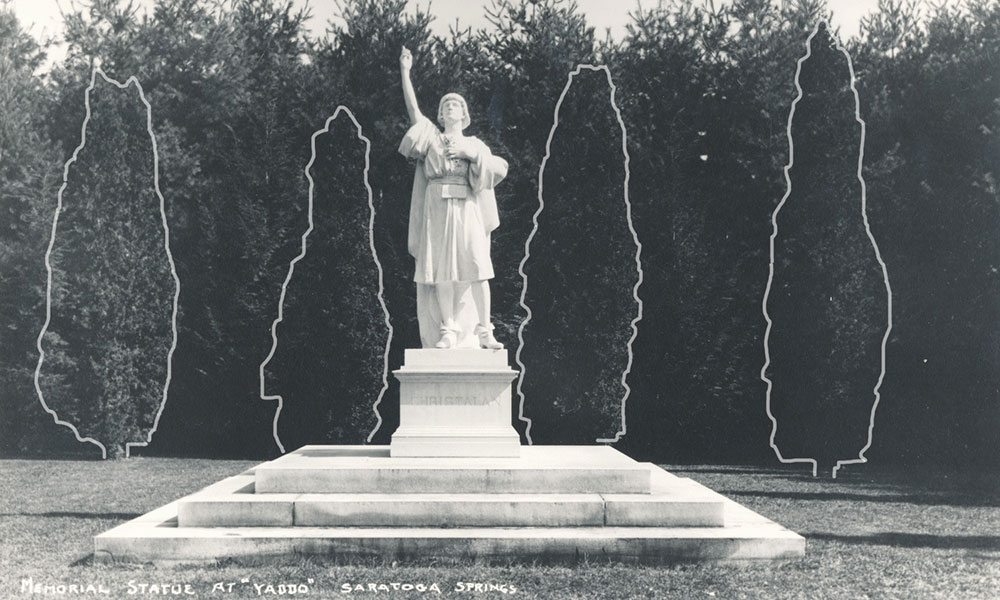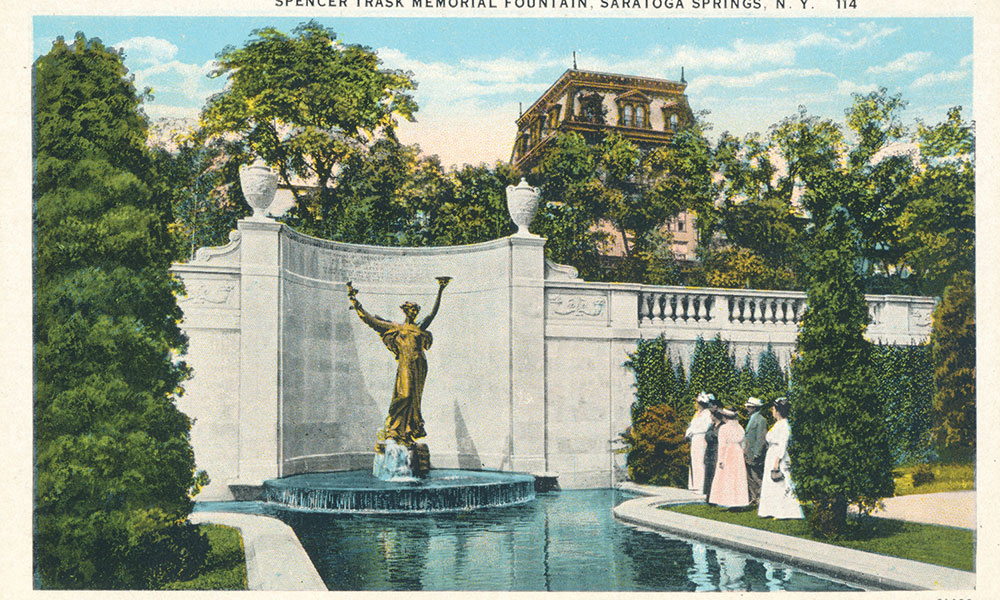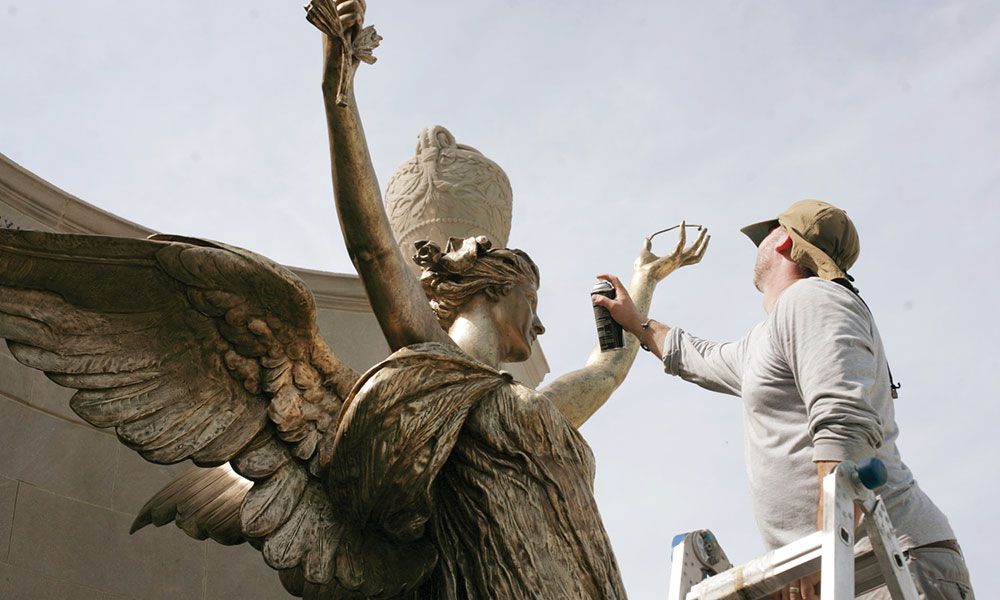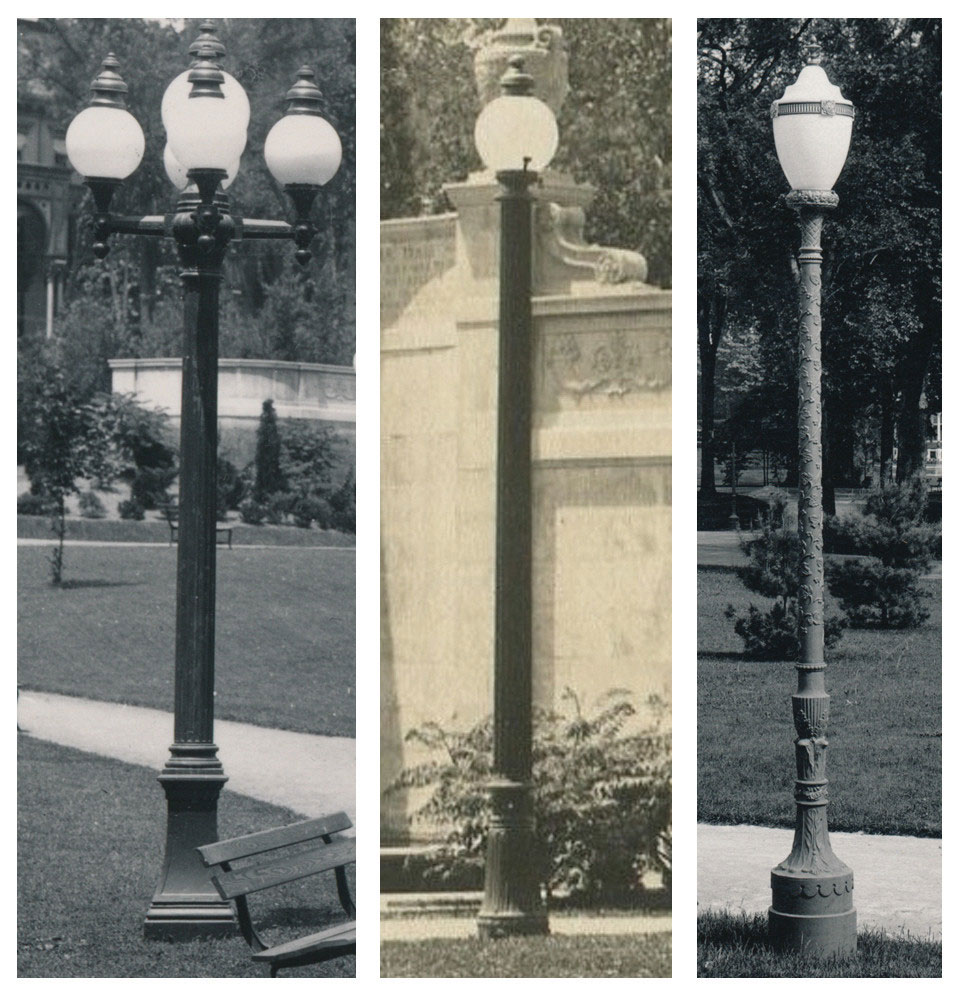In 1917, sculptor Daniel Chester French returned to Saratoga to visit his 1915 masterwork, The Spirit of Life. A century later, we revisit the 2015 Trask Memorial Restoration Project. Why did landscape designer Charles W. Leavitt Jr.’s 1914 “Plantings Plan for Congress Hall Park” include a dense cluster of 59 evergreen trees in the oval above the statue? We now step back in time to search for answers at the great Yaddo estate.
Katrina Trask, an invalid confined to her upper floor rooms at Yaddo, exerted powerful influence over every aspect of the memorial design through letters, telegrams, visits from the designers, and communications through her lifelong friend, admirer, and now emissary, George F. Peabody. Peabody recognized Katrina’s “extraordinary genius in art apprehension and conception;” he would refer to the statue itself, whose design evolved continuously out of Katrina’s dialogue with French, as a “beautiful embodiment of a poet’s dream — a rare work of the sculptor — truly inspired, as I feel, by ‘The Ladye of Yaddo.’”
The Ladye’s love for pine trees derived from a rich heritage. Decades before the Trasks created Yaddo, the land was owned by a German settler, Jacobus Barhydt. His lovely blue lake, stocked with trout, enticed adventurous visitors from nearby Saratoga to fish up a dinner that he would then prepare. Travel writer Nathaniel P. Willis described a visit to Barhydt in his 1840 book American Scenery: “The sky is supported above him (or looks to be) by a wilderness of straight columnar pine-shafts, gigantic in girth, and with no foliage except at the top, where they branch out like pine tables spread for a banquet beneath the clouds.”
White pine forests once covered the Northeast. Their trunks — some upwards of 200 feet — were harvested for buildings and ships, and even burned to make way for crops and livestock. When the Trasks arrived in 1881, much of Barhydt’s forest had disappeared, but a few of the giants still stood. From her high tower window, Katrina could see one “majestic sentinel” white pine that made the surrounding countryside look Lilliputian, with its lower branches spreading 80 feet tip to tip. “I wanted to stay and lie under its branches,” she mused, “to look up to the infinite blue through its tracery, to listen to its music, and to hear its secrets — for the trees of Yaddo have a way of telling me their secrets.”
This sentinel fell in 1917, and today the dull roar of the Northway sounds the dominant note in the Yaddo gardens; we must imagine Katrina’s very different world, where the “music of the wind in the trees” accompanied “the magic in the heart of the woods.”
The Trasks chose to leave much of the woods wild where, as Spencer explained, “the gardeners may not touch a single broken limb.” In the woods they staged pageants and bonfire parties, wandered down “pine-arched path[s], carpeted with pine needles,” read poetry “to the andante of the pine trees.” It was in the woods that Katrina hunted for fairies with the children, and there that she retreated for “blessed solitude.” When a guest wondered why he wasn’t finding Katrina on the piazza of the United States Hotel, she mused, “I always enjoyed… the music and the gay, swirling life… but my woodland solitude was by far the keener enjoyment.”
One afternoon out on a walk in 1899, the Lord and his Ladye arrived at the edge of the woods — and it was there that Katrina experienced the vision of the future of Yaddo, long in question since the deaths of their four children. She saw “literary men, literary women, and other artists… walking in the woods, wandering in the garden, sitting under the pine trees… creating, creating, creating!” The future artist colony bore the name “Pine Garde,” later to be changed to Yaddo. It gave the Trasks a reason to keep enhancing their wonderful home, and that winter they staked out a massive rose garden at the foot of Katrina’s beloved white pine sentinel (above).

In 1897, Spencer masqueraded as a pine tree in a Yaddo pageant, “tall and splendid” as Katrina described, “in a ‘coat of pine-cone armour interspersed with pine-tassels and a helmet covered with pine plumes.’” Thus the pine began a new role at Yaddo as Spencer’s heraldic symbol, used both as a decorative device and a visual emblem denoting his best qualities: “steadfastness, staunchness, protection for the weary, refreshing shadow in the heat, safe shelter in the storm, constant giving of help.” The pine, intertwined with Katrina’s rose symbol, which represented “a glowing heart of love, fragrance, the lavish outpouring of self,” soon appeared on the household silver, in “gay, bright garlands” on the walls, embossed on a bronze plaque on the front door; and as visitors paid homage, “stamped, engraved or embroidered” on gifts. In Katrina’s room, “always there [was] a vase holding a spray of fresh pine with a rose nestling in the feathery plumes.”
The arrangement in her vase translated to a grand scale when “a thicket of white pines” was planted surrounding the rose garden on its eastern and southern edges. A few of these pines remain today, towering over beautiful young rosebushes planted in the garden’s 2009 restoration.
The Trasks designed their complex, 600-acre Yaddo landscape and all of its gardens themselves, eschewing the services of a landscape architect. Katrina applied her razor-sharp sense of aesthetic to many decisions including planning “from which spot the dense green of the boscage [massed trees] would make a favorable background for a work of art.” In the square grotto of her heroic marble sculpture “Christalan,” by William Ordway Partridge, erected as a memorial to the four lost Trask children, the choice was a feathery backdrop of hemlock spruce and long-needled Himalayan pine, with a front row of evenly spaced dark conical arborvitae.
In Congress Park, the stone niche at the Trask Memorial, a creative solution to the sloping land, meant that The Spirit of Life’s pine backdrop emerged higher than her head. Daniel Chester French was well aware that “Mrs. Trask feels strongly that this great inspirational statue of life needs no other background than the mass of pine trees,” although she did recognize the beauty of the “terrace background.” French set up potted white pines in his Chesterwood studio behind his full-size working model (fig. 3). These would both serve as a reminder of her planned pine backdrop and help him to model The Spirit of Life’s “branch of white pine [in the right hand] which had come to be a symbol of Mr. Trask.”
Katrina intended Yaddo’s heraldic symbols to function as visual mantras, oft-repeated reminders of the ideals they represented: “outward sign[s] of an inward meaning.” The bank of white pine branches waving over The Spirit of Life would echo the white pine branch in her hand, just as Katrina’s “phalanx of young [white] pines” behind her Yaddo rose beds echoed the “majestic sentinel.” Her poem The Pine and The Rose put these ideals in verse: “O may you be as steadfast as the Pine; unchanged by sorrow, and untouched by storm; Your head, unbowed by all adversity, Held ever high and looking to the stars.” She felt that as beautiful as a garden was, “it will be more — not less — because it is also beautiful in its meaning and significance.”
Charles W. Leavitt Jr.’s plan shows a woodsy tangle with periwinkle vine covering the floor under the 59 evergreen trees, and autumn white-flowering clematis and bittersweet vines climbing among their branches. Katrina honored the place of both “free, poetic, idyllic” areas, and “formal, orderly, conventional” areas in a garden. Codified by Sir Francis Bacon in his 1625 essay Of Gardens, the garden design principle of juxtaposing wild and formal areas had governed European park and estate design — with which Katrina was well familiar — for hundreds of years. For Katrina, this represented the ideal of balance in life, for “it was our purpose in our garden to express the Ideal; to make the Ideal real and the real Ideal.” Orderly vs. unruly translated to “alternatives are forced upon us; we have yet to learn that poise and proportion are the keynote of the highest development.”
Katrina found formality in a garden artificial and wrote, “let us have none of it,” unless it resonated with symbolism. The formal side of the Trask Memorial — the statue, reflecting pool and wall — did carry meaning, varying somewhat depending on who defined it. President John Finley of the State University of New York, who gave the 1915 dedication address, saw “the precious gift of life which flows in the water under the earth;” Peabody saw “the spiritual quality of Spencer and his most dominant feelings respecting Saratoga, and his hopes towards the future;” poet Henry Van Dyke, whose daughter unveiled The Spirit of Life at the dedication, saw “a message in bronze, saying silently to the children of men that life is not a care and a burden but a blessing and a joy, to all who live in purity and love.”

For the spa visitor seeking healing, who stepped off Broadway to walk the slow curve around a mysterious patch of impenetrable woods and discovered rippling waters pouring from The Spirit of Life’s golden form, the journey had hints of a spiritual pilgrimage. A widely held belief at the time also identified forests with physical healing, as pine-scented breezes and clean living drew thousands north seeking the “fresh-air cure” for tuberculosis, a disease affecting nearly 1½ percent of the population.
In 1917, French visited the memorial and reported to Mrs. Trask, “It is evident that someone looks after it all most carefully. Everything was in perfect order, apparently not a leaf out of place.” The scene was lush and green. A line of five arborvitae along each side of the pool continued with three more along each side of the back wall, nestled between shoulder-high clumps of sumac in a thick layer of periwinkle vinca vine. Ivy rose up the walls, ending about two-thirds of the way in sharp points defined by lines French had marked. Evergreen trees emerging above the balustrade appeared dark against the lacy screen of elm fronds that obscured the Grand Union Hotel.
However, it would not be long before maintenance fell by the wayside. Somewhere between two world wars, Prohibition and the Great Depression, the ivy crept far beyond the lines, the statue turned black and, without pruning and thinning, the forest overwhelmed itself until only the front row of white pines remained.
Today, concern for the safety of the restored wall prevents the reintroduction of ivy. In general, landscape architect Martha Lyon explains, “the city has limited funds for maintenance,” which points to a preference for under-planting. In a grand shift of purpose, the 2015 restoration stepped away from the original idea of a miniature forest in the upper oval. Today’s great open lawn welcomes picnickers between its 18 widely spaced conical spruces. No matter that the visitors who lean over the balustrade would have annoyed French: “The effect of people[’]s heads bobbing around over the statue does not appeal to me.” Today as then, the unknowing visitor is drawn to wander around the curved path and discover a beautiful golden form.

Katrina had wanted The Spirit of Life carved of white marble like Christalan, her memorial statue at Yaddo. She equated white with uplift and, in her later life, following the loss of her first mansion, her four children, and then her husband, she wore only white. The magnificent high Tower Room where she wrote and entertained was also white. But carving a marble statue required a more compact form than The Spirit of Life’s, so French proposed a special “bronze with an alloy of aluminum” that he had developed with the Gorham Company “that will hold a beautiful gold bronze color,” telling Katrina, “I hate the black bronzes as much as you do.” In the historic record, 13 letters exist regarding the statue’s color and its unusual cleaning instructions, and this record indicates clearly that French did not create a brown patina (chemical coating) for The Spirit of Life as he did for many of his other bronzes.
Josh Craine, principal at Daedalus Conservators, which restored The Spirit of Life in 2015, adapted the Gorham Company’s 1916 cleaning instructions to modern tools, stripping the coating “to the bare metal and then just put[ting] a little bit of umber on top of it so it had a golden sheen” and adding powdered mica to shine up marks of wear. “It’s a beautiful sculpture and it’s in a beautiful setting and it was a joy to work on,” he remembers fondly.
In 1915, Peabody extolled French’s vision for “this true Angel of Life, so fittingly stepping down from above to pour out lavishly the water of life, springing from the thus discovered depths through the pressure of the mountains around.” This description of The Spirit of Life pouring out spring water was in fact more real than metaphor. A handwritten receipt for “running spring water to fountain” from the James A. Ryall, Plumbing and Heating company, with offices in the Patterson Spring Building on Phila Street, lists a page and a half of pipe segments, valves, nipples, unions and plumber labor hours. French discussed the Trask Memorial with International Studio Magazine in 1916: “It is rare that a fountain has any water, but in this case there is an unlimited supply, and perfectly clear sparkling water at that.” Today, the pool is fed by city water.
French arrived early in June of 1915 to make sure that the 3,000-pound statue was set correctly on its 5,000-pound granite base and to address the water flow, for “most of the water [that] is falling over the edge follows the line of the wall of the basin instead of falling directly from the lip.” One hundred years later, Department of Public Works Commissioner “Skip” Scirocco recalls reworking the valve system inside the statue after the fountain was replumbed as part of the 2015 restoration, in order to create enough pressure for a good amount of water to rise up the arm and into the bowl. He happily concludes, “and right now it’s flowing pretty good: it worked.”

French continued to fine-tune in July 1915, addressing Bacon regarding the water in the main pool: “I consider that a bowl of this kind should be filled to the brim… the water level is, I should say, eight inches below the rim.” French desired it “within two or two and one-half inches of the moulding.” Today there is concern that a full pool might overflow in a deluge of rain and wash away the surrounding landscaping, so the pool is kept lower.
French attended the first dedication at the completion of the landscaped setting in July 1914, and came away with a few adjustments in mind prior to the 1915 arrival of the statue. He called the elegant multi-globe gas-powered fixtures the village had placed along the paths in the new Congress Park “hideous.” (fig. 6) He wrote Henry Bacon, architect of the memorial, “I see no reason why we shouldn’t make some decent designs for [the lamps closest to the Memorial].” French later wrote Peabody, “I don’t know whether there is any money to pay for those alteration[s] or not, but I think we must do it anyway.” Bacon drew up a blueprint while French offered to pay, stating “it will be a manifest improvement to the monument.” Peabody and Leavitt weighed in on the shape of the globes, choosing a spherical single globe similar to those on the Grand Union Hotel’s front porch across Broadway. By the 1915 dedication, the four gas-powered custom-designed lamps were in place.
Just five years later, the city purchased new electric Novalux “standards” from General Electric and replaced all the fixtures in the park, as well as those along Broadway. Saratoga heralded the new system, among the first in the country to have a turn-down option for lower light, with a grand Illumination Carnival on June 19, 1920, attended by 50,000 people. When Lieutenant Governor Harry C. Walker flipped a switch at 9 p.m., “a gasp of wonderment, and a throaty volume of ‘Ohs’ rolled back;” The Saratogian editorialized, “In full truth, night-time is turned into day-time on Broadway.”
The Trask Memorial Restoration Project has effected its own dramatic change in the park. Samantha Bosshart, executive director of the Saratoga Springs Preservation Foundation, remembers, “[The Spirit of Life] entrance wasn’t even used… it was dark, it wasn’t inviting.” Commissioner Scirocco agrees that now “you walk right in from Broadway into the Spirit of Life… and I think that was part of the reason why we wanted to do what we did.” Site Lead J.C. McCashion adds, “It was a difficult project… with a real tight timeframe,” but “the whole project was beautiful. To be able to work on something historic like that — [it was] once in a lifetime.” Perhaps, too, the welcoming paths, beautiful landscape, and bright, uplifting statue with its inscription, “HIS ONE OBJECT IN LIFE WAS TO DO RIGHT AND TO SERVE HIS FELLOW MEN,” remind visitors of what the Ladye saw: “a heroic figure standing in the center of this little community to teach men that life means giving — loving — and rising above the World and the things of the World.”


